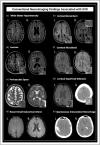Cerebral small vessel disease and vascular cognitive impairment: from diagnosis to management
- PMID: 33630769
- PMCID: PMC7984766
- DOI: 10.1097/WCO.0000000000000913
Cerebral small vessel disease and vascular cognitive impairment: from diagnosis to management
Abstract
Purpose of review: We present recent developments in the field of small vessel disease (SVD)-related vascular cognitive impairment, including pathological mechanisms, updated diagnostic criteria, cognitive profile, neuroimaging markers and risk factors. We further address available management and therapeutic strategies.
Recent findings: Vascular and neurodegenerative pathologies often co-occur and share similar risk factors. The updated consensus criteria aim to standardize vascular cognitive impairment (VCI) diagnosis, relying strongly on cognitive profile and MRI findings. Aggressive blood pressure control and multidomain lifestyle interventions are associated with decreased risk of cognitive impairment, but disease-modifying treatments are still lacking. Recent research has led to a better understanding of mechanisms leading to SVD-related cognitive decline, such as blood-brain barrier dysfunction, reduced cerebrovascular reactivity and impaired perivascular clearance.
Summary: SVD is the leading cause of VCI and is associated with substantial morbidity. Tackling cardiovascular risk factors is currently the most effective approach to prevent cognitive decline in the elderly. Advanced imaging techniques provide tools for early diagnosis and may play an important role as surrogate markers for cognitive endpoints in clinical trials. Designing and testing disease-modifying interventions for VCI remains a key priority in healthcare.
Copyright © 2021 The Author(s). Published by Wolters Kluwer Health, Inc.
Conflict of interest statement
There are no conflicts of interest.
Figures



Similar articles
-
New insights into cerebral small vessel disease and vascular cognitive impairment from MRI.Curr Opin Neurol. 2018 Feb;31(1):36-43. doi: 10.1097/WCO.0000000000000513. Curr Opin Neurol. 2018. PMID: 29084064 Review.
-
Cerebral small vessel disease: Recent advances and future directions.Int J Stroke. 2023 Jan;18(1):4-14. doi: 10.1177/17474930221144911. Int J Stroke. 2023. PMID: 36575578 Free PMC article. Review.
-
Modified cerebral small vessel disease score is associated with vascular cognitive impairment after lacunar stroke.Aging (Albany NY). 2021 Feb 1;13(7):9510-9521. doi: 10.18632/aging.202438. Epub 2021 Feb 1. Aging (Albany NY). 2021. PMID: 33535189 Free PMC article.
-
Blood biomarkers of vascular dysfunction in small vessel disease progression: Insights from a longitudinal neuroimaging study.Alzheimers Dement. 2025 Apr;21(4):e70152. doi: 10.1002/alz.70152. Alzheimers Dement. 2025. PMID: 40275856 Free PMC article.
-
New horizons in cognitive and functional impairment as a consequence of cerebral small vessel disease.Age Ageing. 2023 Aug 1;52(8):afad148. doi: 10.1093/ageing/afad148. Age Ageing. 2023. PMID: 37585592 Free PMC article.
Cited by
-
Combined Score of Perivascular Space Dilatation and White Matter Hyperintensities in Patients with Normal Cognition, Mild Cognitive Impairment, and Dementia.Medicina (Kaunas). 2022 Jul 1;58(7):887. doi: 10.3390/medicina58070887. Medicina (Kaunas). 2022. PMID: 35888606 Free PMC article.
-
Domain-specific neuropsychological investigation of CAA with and without intracerebral haemorrhage.J Neurol. 2023 Dec;270(12):6124-6132. doi: 10.1007/s00415-023-11977-8. Epub 2023 Sep 6. J Neurol. 2023. PMID: 37672105 Free PMC article.
-
Prevotella histicola Transplantation Ameliorates Cognitive Impairment and Decreases Oxidative Stress in Vascular Dementia Rats.Brain Sci. 2023 Jul 29;13(8):1136. doi: 10.3390/brainsci13081136. Brain Sci. 2023. PMID: 37626492 Free PMC article.
-
Correlation between serum ANGPTL4 levels and white matter hyperintensity and cognitive impairment in patients with cerebral small vessel disease.Brain Behav. 2024 Feb;14(2):e3401. doi: 10.1002/brb3.3401. Brain Behav. 2024. PMID: 39470400 Free PMC article.
-
Genome-Wide Association Studies of 3 Distinct Recovery Phenotypes in Mild Ischemic Stroke.Neurology. 2024 Feb 13;102(3):e208011. doi: 10.1212/WNL.0000000000208011. Epub 2024 Jan 5. Neurology. 2024. PMID: 38181310 Free PMC article.
References
-
- Flier WM, van der, Skoog I, et al. . Vascular cognitive impairment. Nat Rev Dis Primers 2018; 4:18003. - PubMed
-
- Wolters FJ, Ikram MA. Epidemiology of vascular dementia. Arterioscler Thromb Vasc Biol 2019; 39:1542–1549. - PubMed
-
This review highlights the multifactorial nature of cognitive decline in the elderly, and suggests that definitions and classifications in the field of dementia should acknowledge the potential contributions from different pathways.
-
- Boyle PA, Yu L, Wilson RS, et al. . Person-specific contribution of neuropathologies to cognitive loss in old age. Ann Neurol 2018; 83:74–83. - PMC - PubMed
-
A recent clinical–pathologic populational study on the prevalence and co-occurrence of multiple neuropathologies in the elderly, quantifying their contributions to cognitive loss at the individual level.
-
- Dichgans M, Leys D. Vascular cognitive impairment. Circ Res 2017; 120:573–591. - PubMed
Publication types
MeSH terms
LinkOut - more resources
Full Text Sources
Other Literature Sources
Medical
Research Materials

